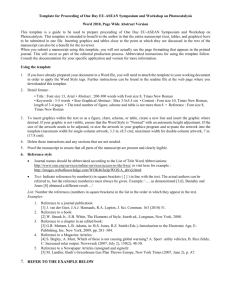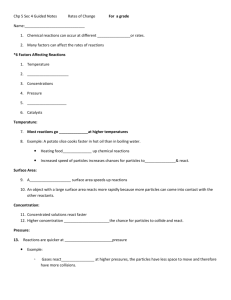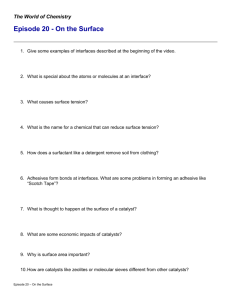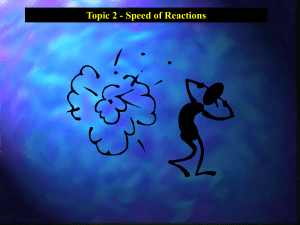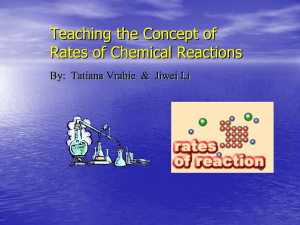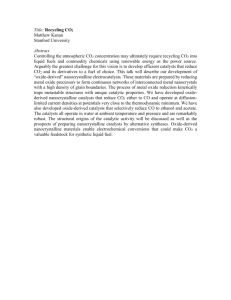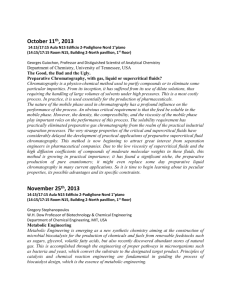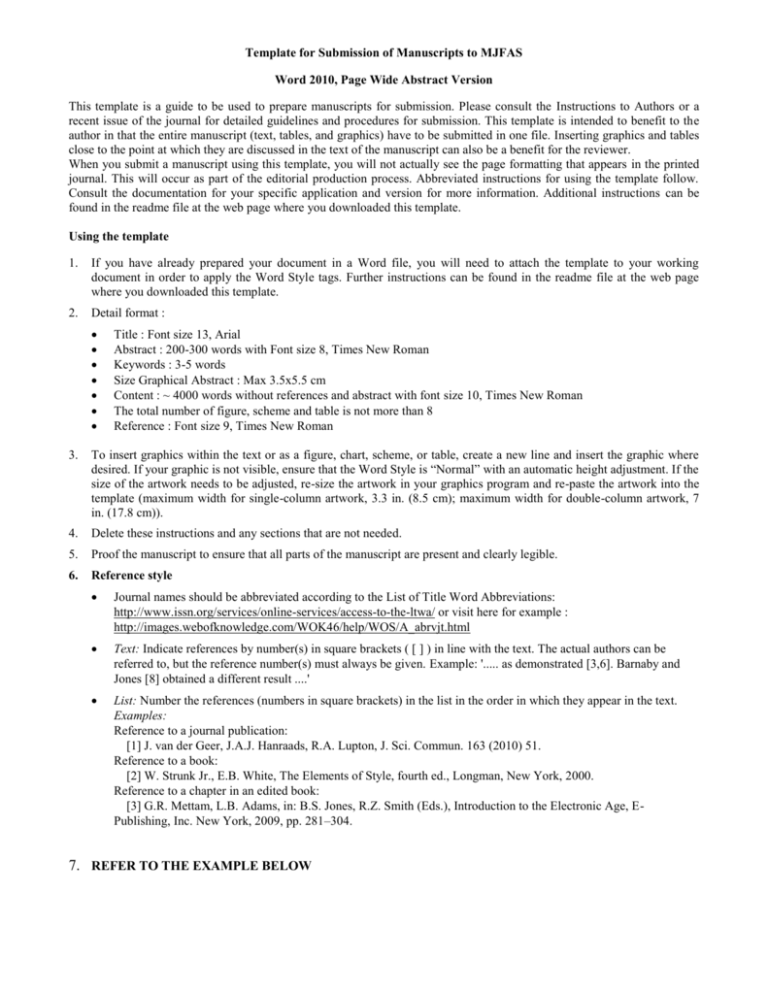
Template for Submission of Manuscripts to MJFAS
Word 2010, Page Wide Abstract Version
This template is a guide to be used to prepare manuscripts for submission. Please consult the Instructions to Authors or a
recent issue of the journal for detailed guidelines and procedures for submission. This template is intended to benefit to the
author in that the entire manuscript (text, tables, and graphics) have to be submitted in one file. Inserting graphics and tables
close to the point at which they are discussed in the text of the manuscript can also be a benefit for the reviewer.
When you submit a manuscript using this template, you will not actually see the page formatting that appears in the printed
journal. This will occur as part of the editorial production process. Abbreviated instructions for using the template follow.
Consult the documentation for your specific application and version for more information. Additional instructions can be
found in the readme file at the web page where you downloaded this template.
Using the template
1.
If you have already prepared your document in a Word file, you will need to attach the template to your working
document in order to apply the Word Style tags. Further instructions can be found in the readme file at the web page
where you downloaded this template.
2.
Detail format :
Title : Font size 13, Arial
Abstract : 200-300 words with Font size 8, Times New Roman
Keywords : 3-5 words
Size Graphical Abstract : Max 3.5x5.5 cm
Content : ~ 4000 words without references and abstract with font size 10, Times New Roman
The total number of figure, scheme and table is not more than 8
Reference : Font size 9, Times New Roman
3.
To insert graphics within the text or as a figure, chart, scheme, or table, create a new line and insert the graphic where
desired. If your graphic is not visible, ensure that the Word Style is “Normal” with an automatic height adjustment. If the
size of the artwork needs to be adjusted, re-size the artwork in your graphics program and re-paste the artwork into the
template (maximum width for single-column artwork, 3.3 in. (8.5 cm); maximum width for double-column artwork, 7
in. (17.8 cm)).
4.
Delete these instructions and any sections that are not needed.
5.
Proof the manuscript to ensure that all parts of the manuscript are present and clearly legible.
6.
Reference style
Journal names should be abbreviated according to the List of Title Word Abbreviations:
http://www.issn.org/services/online-services/access-to-the-ltwa/ or visit here for example :
http://images.webofknowledge.com/WOK46/help/WOS/A_abrvjt.html
Text: Indicate references by number(s) in square brackets ( [ ] ) in line with the text. The actual authors can be
referred to, but the reference number(s) must always be given. Example: '..... as demonstrated [3,6]. Barnaby and
Jones [8] obtained a different result ....'
List: Number the references (numbers in square brackets) in the list in the order in which they appear in the text.
Examples:
Reference to a journal publication:
[1] J. van der Geer, J.A.J. Hanraads, R.A. Lupton, J. Sci. Commun. 163 (2010) 51.
Reference to a book:
[2] W. Strunk Jr., E.B. White, The Elements of Style, fourth ed., Longman, New York, 2000.
Reference to a chapter in an edited book:
[3] G.R. Mettam, L.B. Adams, in: B.S. Jones, R.Z. Smith (Eds.), Introduction to the Electronic Age, EPublishing, Inc. New York, 2009, pp. 281–304.
7. REFER TO THE EXAMPLE BELOW
Regional
Annual
Fundamental
Symposium
2014 (RAFSS
2014) xx-xx
Malaysian
Journal
of Fundamental
andScience
Applied
Sciences Vol.xx,
No.x (2014)
Property-activity relationship of WO3 in n-butane isomerization evidenced by
hydrogen adsorption and IR studies
Muhammad Aziza, Ahmad Suhaimib,c,*
a
Institute of Hydrogen Economy, Universiti Teknologi Malaysia, 81310 UTM Johor Bahru, Johor, Malaysia.
Department of Chemical Engineering, Faculty of Chemical Engineering, Universiti Teknologi Malaysia, 81310 UTM Johor Bahru, Johor, Malaysia
c
Department of Chemistry, Faculty of Science, Universiti Teknologi Malaysia, 81310 UTM Johor Bahru, Johor, Malaysia.
b
*Corresponding Author: suhaimi@utm.my
Article history :
Received 1 February 2013
Revised 20 July 2013,
Accepted 25 July 2013,
Available online 15 August 2013
GRAPHICAL ABSTRACT
ABSTRACT
Mesostructured silica nanoparticles (MSN) supported metal catalysts have been studied for elucidation
of the mechanism of CO2 methanation. The property-activity relationship of WO3 supported on ZrO2
(WZ) was evaluated in n-butane isomerization for a series of catalysts with WO3 loading ranging from
5 to 20 wt% on ZrO2. The catalysts were prepared by incipient-wetness impregnation of Zr(OH)4 with
an aqueous solution of (NH4)6[H2W12O40∙nH2O], followed by drying and calcination at 1093 K. The
introduction of WO3 continuously increased the tetragonal phase of ZrO2, WO3 surface density and
coverage. The specific surface area and total pore volume passed through a maximum of WO3 loading
at 13 wt%; this loading corresponds to 5.9 WO3/nm2 and is near the theoretical monolayer-dispersed
limit of WO3 on ZrO2. The IR results indicate that the presence of WO3 eroded the absorbance bands
at 3738 and 3650 cm-1 corresponding to bibridged and tribridged hydroxyl groups up to near the
monolayer-dispersed limit of WO3. A new broad and weak band appeared, centered at 2930 cm-1,
indicating the presence of bulk crystalline WO3 for WO3 coverage exceeding the theoretical
monolayer-dispersion limit. However, the bridged carbonyl species could be a main route to form a
methane since it was dominant than other adsorbed species. The results, discussion and suggestions
provided new perspectives in the catalysis, particularly in the recycling of CO2.
Keywords: protein domains, HMM models, GO classification, functional genome
© 2014 Penerbit UTM Press. All rights reserved
| 1823-626X | http://dx.doi.org/xx.xxx/xxx.xxx.xxx |
adsorption studies, we have proposed the concept of
“molecular hydrogen-originated protonic acid sites” that
involves the generation of protonic acid sites on the surface
of solid acid materials from molecular hydrogen [9-13].
Hydrogen molecules are dissociatively adsorbed on
specific active sites to form hydrogen atoms, followed by
spillover onto the acid site. The Lewis acid site trapped
electron reacts with a second acid site. The Lewis acid site
trapped electron reacts with a second spiltover hydrogen to
form H− bound to a Lewis acid site. The Lewis acid site
trapped electron reacts with a second spiltover hydrogen to
form H− bound to a form H−bound to a Lewis acid site.
The Lewis acid site trapped electron reacts with a second
spiltover hydrogen to form H− bound to a Lewis acid site
Zirconia-based solid acid catalysts such as SO42--ZrO2
(SZ), MoO3-ZrO2 (MZ) and WO3-ZrO2 (WZ) catalysts
have been explored widely due to their potential for
replacing halide-type solid acids and zeolite for linear
alkane isomerization [1-7]. Skeletal isomerization over
solid acid catalysts is normally carried out in the presence
1. INTRODUCTION
Zirconia-based solid acid catalysts such as SO42--ZrO2
(SZ), MoO3-ZrO2 (MZ) and WO3-ZrO2 (WZ) catalysts
have been explored widely due to their potential for
replacing halide-type solid acids and zeolite for linear
alkane isomerization [1-7]. Skeletal isomerization over
solid acid catalysts is normally carried out in the presence
of hydrogen. Without hydrogen, catalytic activity decreases
rapidly with the reaction time due to the formation of coke
deposits and/or the lack of active sites for isomerization.
Our research group has studied the effects of hydrogen on
the catalytic activities of SZ, MZ and WZ catalysts for
acid-catalyzed reactions [8-10]. Our results suggest that
protonic acid sites are generated from molecular hydrogen
and act as catalytically active sites, not only for the skeletal
isomerization of alkanes, but also for acid-catalyzed
reactions such as cumene cracking and toluene
disproportionation. On the basis of pyridine adsorbed IR,
hydrogen adsorbed ESR and quantitative hydrogen
1
Regional Annual Fundamental Science Symposium 2014 (RAFSS 2014)
of hydrogen. Without hydrogen, catalytic activity decreases
rapidly with the reaction time due to the formation of coke
deposits and/or the lack of active sites for isomerization.
Our research group has studied the effects of hydrogen on
the catalytic activities of SZ, MZ and WZ catalysts for
acid-catalyzed reactions [8-10]. Our results suggest that
protonic acid sites are generated from molecular hydrogen
and act as catalytically active sites, not only for the skeletal
isomerization of alkanes, but also for acid-catalyzed
reactions such as cumene cracking and toluene
disproportionation. On the basis of pyridine adsorbed IR,
hydrogen adsorbed ESR and quantitative hydrogen
adsorption studies, we have proposed the concept of
“molecular hydrogen-originated protonic acid sites” that
involves the generation of protonic acid sites on the surface
of solid acid materials from molecular hydrogen [9-13].
Hydrogen molecules are dissociatively adsorbed on
specific active sites to form hydrogen atoms, followed by
spillover onto the acid site. The Lewis acid site trapped
electron reacts with a second acid site. The Lewis acid site
trapped electron reacts with a second spiltover hydrogen to
form H− bound to a Lewis acid site. The Lewis acid site
trapped electron reacts with a second spiltover hydrogen to
form H− bound to a form H− bound to a Lewis acid site.
The Lewis acid site trapped electron reacts with a second
spiltover hydrogen to form H− bound to a Lewis acid site
2.
pretreatment and reaction temperatures. The catalyst was
sieved and selected in the 20-40 µm fraction. Initially, 200
mg of catalyst was treated in an oxygen stream (FOxygen =
100 ml/min) for 1 h followed by a hydrogen stream
(FHydrogen = 100 ml/min) for 4 h at 773 K and cooled
down to the desired reaction temperature in a hydrogen
stream. The conversion of carbon dioxide, selectivity of
products and rate of methane formation were calculated by
the following equations:
𝑋𝐶𝑂2 (%) =
𝑆𝑥 (%) =
FCO2,in −FCO2,out
FCO2,in
Fx,out
FCO2,in −FCO2,out
𝑟𝑎𝑡𝑒 (𝑠 −1 ) =
× 100%
× 100%
Fx,out
mole of MTotal
(1)
(2)
(3)
where XCO2 is the conversion of carbon dioxide (%), Sx is
the selectivity of x product (%) in which x is a CH4 or CO,
F is a molar flow rate of CO2 or product in mole per
second and MTotal is the total amount of metal in mole.
3.
RESULTS AND DISCUSSION
Figure 1A shows the small-angle XRD patterns of MSN
and metals based MSN catalysts. The patterns exhibited
three peaks, indexed as (100), (110) and (200) which are
reflections of the typical two dimensional hexagonally
ordered mesostructure (p6mm), demonstrating the high
quality of mesopore packing. The presence of metal
crystallites on the catalysts were characterized using wideangle XRD (30-90°), as shown in Figure 1B.
The crystal phase, specific surface area, total pore
volume, The Lewis acid site trapped electron reacts with a
second spiltover hydrogen to form H− bound to a Lewis
acid site The crystal phase, specific surface area, total pore
volume, The Lewis acid site trapped electron reacts with a
second spiltover hydrogen to form H− bound to a Lewis
acid site The crystal phase, specific surface area, total pore
volume, The crystal phase, specific surface area, total pore
volume, WO3 to tetragonal phases of ZrO2 decreased and,
in contrast, the in and surface area, total pore volume, WO3
surface density and WO3 coverage are summarized in
Table 1. Textural parameters of MSN and metal-based
MSN catalysts are summarized in Table 1. Textural
parameters of MSN and metal-based MSN catalysts are
summarized in Table 1. Textural parameters of MSN and
metal-based MSN catalysts are summarized in Table 1
extural parameters of MSN and metal-based based MSN
catalysts are summarized in Table 1 extural parameters of
MSN and metal-based MSN catalysts are summarized in
Table MSN catalysts are summarized in Table 1 extural
parameters of MSN and metal-based MSN catalysts are
summarized in Table 1extural parameters of MSN and
metal-based MSN catalysts.
EXPERIMENTS
Catalyst Preparation. MSN was prepared by sol-gel
method according to the report by Karim et al.23 The
surfactant cetyltrimethylammonium bromide (CTAB;
Merck), ethylene glycol (EG; Merck) and NH4OH solution
(QRec) were dissolved in water with the following molar
composition
of
CTAB:EG:NH4OH:H2O
=
0.0032:0.2:0.2:0.1. After vigorous stirring for about 30 min
at 353 K, 1.2 mmol of tetraethyl orthosilicate (Merck) and
1 mmol of 3-aminopropyl triethoxysilane (Merck). After
vigorous stirring for about 30 min at 353 K, 1.2 mmol of
tetraethyl orthosilicate (Merck) and 1 mmol of 3aminopropyl triethoxysilane (Merck).
Characterization. The crystalline structure of the
catalyst was determined with X-ray diffraction (XRD)
recorded on a powder diffractometer (Bruker Advance D8,
40 kV, 40 mA) using a Cu Kα radiation source in the range
of 2θ = 1.5-90°. The BET analysis of the catalyst was
determined by N2 adsorption-desorption isotherms using a
Quantachrome Autosorb-1 instrument. The catalyst was
outgassed at 573 K for 3 h before being subjected to N2
adsorption. Pore size distributions and pore volumes were
determined from the sorption isotherms using a non
localized density functional theory (NLDFT) method.
Catalytic Activity Measurements. CO2 methanation
was conducted in a microcatalytic quartz reactor with an
interior diameter of 8 mm at atmospheric pressure at
temperature range of 373-723 K. The thermocouple was
directly inserted into the catalyst bed to measure the actual
2
Regional Annual Fundamental Science Symposium 2014 (RAFSS 2014)
activated and pyridine adsorbed WZ catalysts containing
Table 1. Physicochemical propertiesa and catalytic performanceb
Figure 1. (A) IR spectra in the hydroxyl stretching region for
Table 2. Physicochemical propertiesa and catalytic performanceb
Catalyst
Ag/hzsm5
Cu/hzsm5
SBET
(m2g-1)
Vpore
(cm3g1)
dpore
(Ǻ)
Rate
×
10-2
(molCH4·molMetal1·s-1)
858
0.805
35
0.97
501
0.642
32
0.57
Conversion,
XCO2 (%)
Selectivity (%)c
CH4
4
3.3
CO
92
79
8
21
a SBET: BET surface area; Vpore: total pore volume; dpore: average pore diameter. b Conditions: reaction temperature =
623 K, gas hour space velocity (GHSV) = 50,000 mlg-1h-1, H2/CO2 = 4/1. c Selectivity at conversion = 20%. d Selectivity
at conversion = 0.3%. e The result in the parenthesis shows the reaction in the presence of CO2 only.
Figs. 3 and 4 show the IR spectra in the O-H and W=O
stretching regions of the activated and pyridine adsorbed
WZ catalysts. The catalysts were activated at 673 K,
followed by the adsorption of pyridine at 423 K and
outgassing at 623 K. The activated 5WZ catalyst showed
broad bands centered at 3738 and 3650 cm-1, inferring the
existence of several hydroxyl stretching bands with
different acidic centers and strength (Fig. 3). These bands
were assigned to presence of both the tetragonal and
monoclinic phases of zirconia on the catalyst [18,29]. Both
bands eroded continuously with bibridged and tribridged
hydroxyl groups on the surface were covered by tungstate
anions. Further loading of WO3 led to new broad bands at
3500- crystallite planes, respectively. In addition, two
absorbance bands were observed in the W=O stretching
regions at 1025-2010 cm-1 for all WZ catalysts (Fig. 4).
The main band at a higher wavenumber was relatively
sharp and stronger, and the shoulder band at a lower
wavenumber was much weaker and broader. Increased
WO3 loading did not change the position of the band at
1021 cm-1, whereas the band at 1014 cm-1 was observed
only for the 13WZ catalyst. The peak at 1014 cm-1 shifted
slightly to a lower wavenumber for the 5WZ, 10WZ, 15WZ
and 20WZ catalysts. Based on our previous assigment, the
bands at 1021 and 1014 cm-1 for 13WZ were assigned to
the stretching of W=O connected to coordinative
unsaturated (cus) Zr4+ through O and to the other W
through O, respectively [30].
No dioxo (O=W=O) tungsten oxide species were
present in any of the catalysts, as seen by the absence of IR
bands for symmetric and antisymmetric stretching modes
of the O=W=O bond with different relative intensities and
wavenumbers (30–50 cm−1 difference). The spectra in the
O-H and W=O stretching regions were essentially the same
as those reported by Naito et al. [15] and Scheithauer et al.
[14,23] for dehydrated WZ catalysts. Naito et al. reported a
band assigned to the hydroxyl group observed at 3676 cm-1
for both ZrO2 and WZ catalysts. Although the band
position of the hydroxyl groups varied in the of WO3
loading and following calcination at different temperatures.
Acid site distribution and strength for WZ catalysts were
studied by NH3-TPD and pyridine adsorbed IR
spectroscopy (Fig. 5). The NH3-TPD results show that
ammonia desorbed in one large envelope centered at 453 K
for all WZ catalysts (Fig. 5A). The shoulder band which
emerged when the catalysts were heated to 1200 K reveals
that the surface acid strength was widely distributed on the
catalysts. Gaussian deconvolution of NH3-TPD spectrum
for 13WZ indicated the existence of NH3 desorption peaks
centered at 440, 470, 560, 665 and 720 K which inferring
that there are the existence of NH3 desorption peaks
centered at 440, 470, 560, 665 and 720 K which inferring
that there are.
3
Regional Annual Fundamental Science Symposium 2014 (RAFSS 2014)
Figure 2. Catalytic activity of (A) MSN and (B) Ni at 623 K. (C) Catalytic activity of various metal based MSN at steady state condition as
a function of reaction temperature.
Acid site distribution and strength for WZ catalysts
were studied by NH3-TPD and pyridine adsorbed IR
spectroscopy (Fig. 5). The NH3-TPD results show that
ammonia desorbed in one large envelope centered at 453 K
for all WZ catalysts (Fig. 5A). The shoulder band which
emerged when the catalysts were heated to 1200 K reveals
that the surface acid strength was widely distributed on the
catalysts. Gaussian deconvolution of NH3-TPD spectrum
for 13WZ indicated the existence of NH3 desorption peaks
centered at 440, 470, 560, 665 and 720 K which inferring
that there are several type of acidic centers with different
strengths of acidity (Fig. 5C). No ammonia was desorbed at
900 K and above. The NH3-TPD curves also indicated that
the amount of adsorbed ammonia increased with increasing
WO3 loading and reached a maximum at 13 wt% WO3
loading. This result reveals that the total number of acid
sites was determined by the WO3 coverage in which the
maximum acidity of catalysts was obtained when the ZrO2
catalyst was covered by monolayer-dispersed WO3. In fact,
a further increase in WO3 loading decreased the intensity
of the peaks centered at 453K. Fig. 5B shows the IR spectra
of pyridine adsorbed on WZ catalysts. The IR bands at
1540 and 1450 cm−1 assigned to pyridinium ions adsorbed
on protonic acid sites and pyridine coordinated to Lewis
acid sites appeared for all WZ catalysts, respectively. As
WO3 loading increased, the bands at 1540 and 1450 cm−1
continuously intensified and reached a maximum at 13
wt% WO3 loading. which the maximum acidity of catalysts
was obtained when the ZrO2 catalyst was covered by
monolayer-dispersed WO3. In fact, a further increase in
WO3 loading decreased the intensity of the peaks centered
at 453K. Fig. 5B shows the IR spectra of pyridine adsorbed
on WZ catalysts. The IR bands at 1540 and 1450 cm−1
assigned to pyridinium ions adsorbed on protonic acid sites
and pyridine coordinated to Lewis acid sites appeared for
all WZ catalysts, respectively. As WO3 loading increased,
the bands at 1540 and 1450 cm−1 continuously intensified
and reached a maximum at 13 wt% WO3 loading. which
the maximum acidity of catalysts was obtained when the
ZrO2 catalyst was covered by monolayer-dispersed WO3.
In fact, a further increase in WO3 loading decreased the
intensity of the peaks centered at 453K. Fig. 5B shows the
IR spectra of pyridine adsorbed on WZ catalysts. The IR
bands at 1540 and 1450 cm−1 assigned to pyridinium ions
adsorbed on protonic acid sites and pyridine coordinated to
Lewis acid sites appeared for all WZ catalysts,
respectively. As WO3 loading increased, the bands at 1540
and 1450 cm−1 continuously intensified and reached a
maximum at 13 wt% WO3 loading. which the maximum
acidity of catalysts was obtained when the ZrO2 catalyst
was covered by monolayer-dispersed WO3. In fact, a
further increase in WO3 loading decreased the intensity of
the peaks centered at 453K. Fig. 5B shows the IR spectra of
pyridine adsorbed on WZ catalysts. The IR bands at 1540
and 1450 cm−1 assigned to pyridinium ions adsorbed on
protonic acid sites and pyridine coordinated to Lewis acid
sites appeared for all WZ catalysts, respectively. As WO3
loading increased, the bands at 1540 and 1450 cm−1
continuously intensified and reached a maximum at 13
wt% WO3 loading.
The IR bands at 1540 and 1450 cm−1 assigned to
pyridinium ions adsorbed on protonic acid sites and
pyridine coordinated to Lewis acid sites appeared for all
WZ catalysts, respectively. As WO3 loading increased, the
bands at 1540 and 1450 cm−1 continuously intensified and
reached a maximum at 13 wt% WO3 loading. which the
maximum acidity of catalysts was obtained when the ZrO2
catalyst was covered by monolayer-dispersed WO3. In fact,
a further increase in WO3 loading decreased the intensity
of the peaks centered at 453K. Fig. 5B shows the IR spectra
of pyridine adsorbed on WZ catalysts. The IR bands at
1540 and 1450 cm−1 assigned to pyridinium ions adsorbed
on protonic acid sites and pyridine coordinated to Lewis
acid sites appeared for all WZ catalysts, respectively.
4.
4
CONCLUSION
Regional Annual Fundamental Science Symposium 2014 (RAFSS 2014)
460.
[19] Peebles, D. E.; Goodman, D. W.; White, J. M. J. Phys.
Chem. 87 (1983) 4378.
[20] Fujita, S.; Terunuma, H.; Kobayashi, H.; Takezawa, N.
React. Kinet. Catal. Lett. 33 (1987) 179.
[21] Schild, C.; Wokaun, A.; Baiker, A. J. Mol. Catal. 63 (1990)
243.
[22] Betta, R.A.D.; Shelef, M. J. Catal. 48 (1977) 111.
[23] Karim, A.H.; Jalil, A.A.; Triwahyono, S.; Sidik, S.M.;
Kamarudin, N.H.N.; Jusoh, R.;
Jusoh, N.W.C.; Hameed,
B.H. J. Colloid Interf. Sci. 386 (2012) 307.
[24] de Boer, J.H.; Linsen, B.G.; Osinga, T.J. J. Catal. 4 (1965)
643.
[25] Kučera, J.; Nachtigall, P. J. Phys. Chem. B 108 (2004)
16012.
[26] Wang, J.A.; Novaro, O.; Bokhimi, X.; López, T.; Gómez, R.;
Navarrete, J.; Llanos, M.E.; López-Salinas, E. J. Phy. Chem.
B, 101 (1997) 7448.
[27] Climent, M.J.; Corma, A.; Iborra, S.; Epping, K.; Velty, A. J.
Catal. 225 (2004) 316.
[28] Lavalley, J.C. Catal. Today 27 (1996) 377.
[29] Drouilly, C.; Krafft, J.-M.; Averseng, F.; Lauron-Pernot, H.;
Bazer-Bachi, D.; Chizallet, C.; Lecocq, V.; Costentin, G.
Appl. Catal.: A 453 (2013) 121.
The hydrogen adsorption kinetic behavior is different
between WZ, MZ and Pt/MoO3 catalysts. The ratecontrolling step of hydrogen adsorption is surface diffusion
of spilt-over hydrogen atoms for all WZ, MZ and Pt/MoO3
catalysts with apparent activation energies of 25.9, 62.8 and
83.1 kJ/mol, respectively [32-34]. The difference in the
apparent activation energies may be caused by differences
in the acidity of the catalyst, which leads to differences in
hydrogen-surfaces interaction and/or the ease of surface
diffusion of hydrogen atoms. Other difference among WZ,
MZ and Pt/MoO3 catalysts is the necessity for specific
active sites to facilitate the dissociative adsorption of
hydrogen. The Lewis acid site trapped electron reacts with
a second spiltover hydrogen to form H− bound to a Lewis
acid site Pt is required for MoO3 WZ and MZ.
ACKNOWLEDGEMENTS
This work was supported by Ministry of Science,
Technology
and
Innovation,
Malaysia
through
EScienceFund Research Grant No. 03-01-06-0000, MyPhd
Scholarship (Muhammad Aziz) from Ministry of Higher
Education, Malaysia.
[30] Kester, K.B.; Zagli, E.; Falconer, J.L. Appl. Catal. 22
(1986) 311.
[31] Riani, P.; Garbarino, G.; Lucchini, M.A.; Canepa, F.;
Busca, G. J. Mol. Catal. A: Chem. 383-384 (2014) 10.
[32] Mochizuki, S., Satoh, M. Phys. Stat. Sol. B, 106
(1981) 667.
[33] Medsford, S. J. Chem. Soc. 123 (1923) 1452.
REFERENCES
[1] Centi, G.; Perathoner, S. Catal. Today 148 (2009) 191.
[2] Aziz, M.A.A.; Jalil, A.A.; Triwahyono, S.; Mukti, R.R.;
Taufiq-Yap, Y.H.; Sazegar, M.R. Appl. Catal.: B 147 (2014)
359.
[3] Huang, Y.-H.; Wang, J.-J.; Liu, Z.-M.; Lin, G.-D.; Zhang,
H.-B. Appl. Catal.: A 466 (2013) 300.
[4] Zhang, G.; Sun, T.; Peng, J.; Wang, S.; Wang, S. Appl.
Catal.: A 462-463 (2013) 75.
[5] Du, G.; Lim, S.; Yang, Y.; Wang, C.; Pfefferle, L.; Haller,
G.L. J. Catal. 249 (2007) 370.
[6] Lu, B.; Kawamoto, K. Fuel 103 (2013) 699.
[7] Jwa, E.; Lee, S.B.; Lee, H.W.; Mok, Y.S. Fuel Process.
Technol. 108 (2013) 89.
[8] Aldana, P.A.U.; Ocampo, F.; Kobl, K.; Louis, B.; ThibaultStarzyk, F.; Daturi, M.; Bazin, P.; Thomas, S.; Roger, A.C.
Catal. Today 215 (2013) 201.
[9] Pan, Q.; Peng, J.; Wang, S.; Wang, S. Catal. Sci. Technol. 4
(2014) 502.
[10] Yin, A.-X.; Liu, W.-C.; Ke, J.; Zhu, W.; Gu, J.; Zhang, Y.W.; Yan, C.-H. J. Am. Chem. Soc. 134 (2012) 20479.
[11] Kwak, J.H.; Kovarik, L.; Szanyi, J. ACS Catal. 3 (2013)
2449.
[12] Karelovic, A.; Ruiz, P. ACS Catal. 3 (2013) 2799.
[13] Beuls, A.; Swalus, C.; Jacquemin, M.; Heyen, G.; Karelovic,
A.; Ruiz, P. Appl. Catal.: B 113-114 (2012) 2.
[14] Jacquemin, M.; Beuls, A.; Ruiz, P. Catal. Today 157 (2010)
462.
[15] Galvis, H.M.T.; Bitter, J.H.; Davidian, T.; Ruitenbeek, M.;
Dugulan, A.I.; de Jong, K.P. J. Am. Chem. Soc. 134 (2012)
16207.
[16] Zhou, G.; Wu, T.; Xie, H.; Zheng, X. Int. J. Hydrogen
Energy, 38 (2013) 10012.
[17] Falconer, J. L.; Zagli, A. E. J. Catal. 62 (1980) 280.
[18] Weatherbee, G. D.; Bartholomew, C. H. J. Catal. 77 (1982)
|


